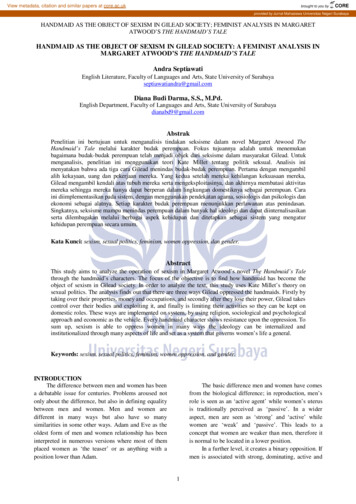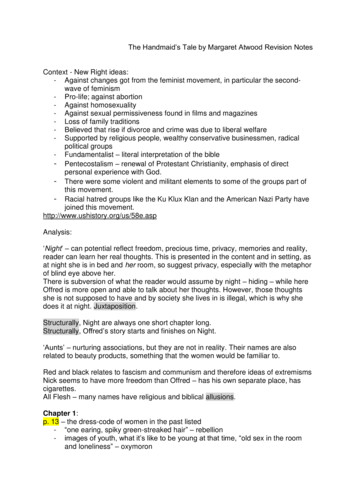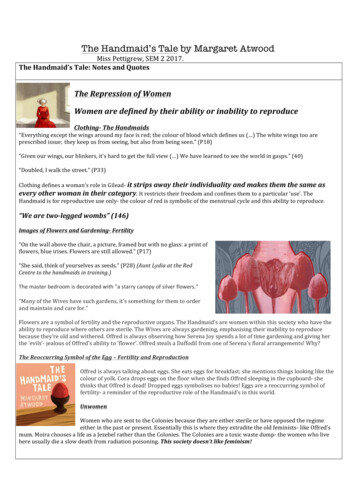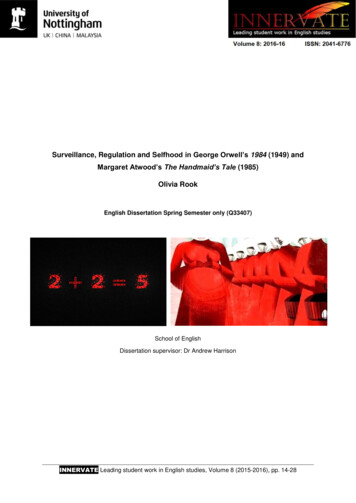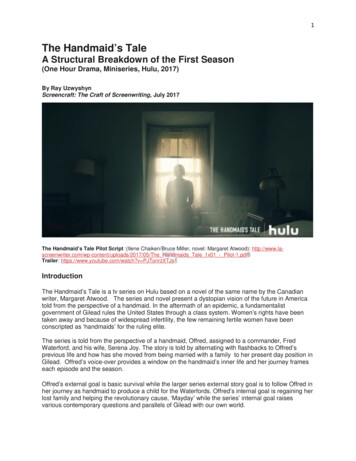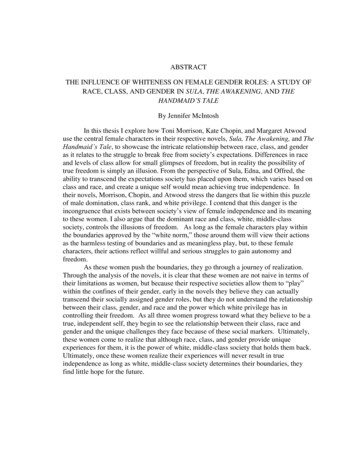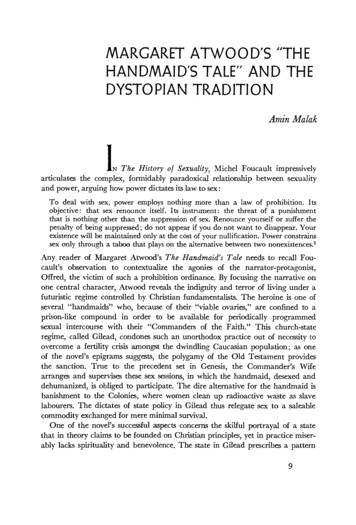
Transcription
MARGARET ATWOOD'S "THEHANDMAID'S TALE" AND THEDYSTOPIAN TRADITIONAmin MalakI.I N The History of Sexuality, Michel Foucault impressivelyarticulates the complex, formidably paradoxical relationship between sexualityand power, arguing how power dictates its law to sex :To deal with sex, power employs nothing more than a law of prohibition. Itsobjective: that sex renounce itself. Its instrument: the threat of a punishmentthat is nothing other than the suppression of sex. Renounce yourself or suffer thepenalty of being suppressed ; do not appear if you do not want to disappear. Yourexistence will be maintained only at the cost of your nullification. Power constrainssex only through a taboo that plays on the alternative between two nonexistences.1Any reader of Margaret Atwood's The Handmaid's Tale needs to recall Foucault's observation to contextualize the agonies of the narrator-protagonist,Offred, the victim of such a prohibition ordinance. By focusing the narrative onone central character, Atwood reveals the indignity and terror of living under afuturistic regime controlled by Christian fundamentalists. The heroine is one ofseveral "handmaids" who, because of their "viable ovaries," are confined to aprison-like compound in order to be available for periodically programmedsexual intercourse with their "Commanders of the Faith." This church-stateregime, called Gilead, condones such an unorthodox practice out of necessity toovercome a fertility crisis amongst the dwindling Caucasian population; as oneof the novel's epigrams suggests, the polygamy of the Old Testament providesthe sanction. True to the precedent set in Genesis, the Commander's Wifearranges and supervises these sex sessions, in which the handmaid, desexed anddehumanized, is obliged to participate. The dire alternative for the handmaid isbanishment to the Colonies, where women clean up radioactive waste as slavelabourers. The dictates of state policy in Gilead thus relegate sex to a saleablecommodity exchanged for mere minimal survival.One of the novel's successful aspects concerns the skilful portrayal of a statethat in theory claims to be founded on Christian principles, yet in practice miserably lacks spirituality and benevolence. The state in Gilead prescribes a pattern
DYSTOPIAof life based on frugality, conformity, censorship, corruption, fear, and terror —in short, the usual terms of existence enforced by totalitarian states, instance ofwhich can be found in such dystopian works as Zamyatin's We, Huxley's BraveNew World, and Orwell's 1984.In order to situate Atwood's novel within the relevant context of dystopia, Iwish to articulate the salient dystopian features those three classics reveal. Theensuing discussion will be an elaboration on Atwood's rendition and redefinitionof those features.1. Power, Totalitarianism, War:Dystopias essentially deal with power: power as the prohibition or perversion ofhuman potential; power in its absolute form that, to quote from 1984, toleratesno flaws in the pattern it imposes on society. Dystopias thus show, in extremeterms, power functioning efficiently and mercilessly to its optimal totalitarianlimit. Interestingly, war or foreign threats often loom in the background, providing the pretext to join external tension with internal terror.2. Dream-Nightmare: Fantasy: Reality:While dystopias may be fear-laden horror fiction (how the dream turns into anightmare), the emphasis of the work is not on horror for its own sake, but onforewarning. Similarly, while dystopias contain elements of the fantastic with a"touch of excess" carrying the narrative "one step [or more] beyond our reality,"2the aim is neither to distort reality beyond recognition, nor to provide an escapistworld for the reader, but "to allow certain tendencies in modern society to spinforward without the brake of sentiment and humaneness."33. Binary Oppositions:Dystopias dramatize the eternal conflict between individual choice and socialnecessity: the individual resenting the replacement of his private volition bycompulsory unif ormitarian decisions made by an impersonal bureaucratic machinery; Zamyatin's heroine poignantly sums up the conflict: "I do not want anyoneto want for me. I want to want for myself."4 The sphere of the binary oppositionexpands further to cover such dialectical dualities as emotion and reason, creativeimagination and mathematical logic, intuition and science, tolerance and judgment, kindness and cruelty, spirituality and materialism, love and power, goodand evil. The list can go on.4. Characterization:Dystopias often tend to offer two-dimensional character types; this tendency ispossibly due to the pressure of the metaphorical and ideological thrust of these10
DYSTOPIAworks. Moreover, the nightmarish atmosphere of dystopias seems to precludeadvancing positive, assertive characters that might provide the reader with consoling hope. If such positive characters do exist, they usually prove miserablyineffectual when contending with ruthless overwhelming powers.5. Change and Time:Dystopian societies, consumed and controlled by regressive dogmas, appear constantly static: founded on coercion and rigid structures, the system resists changeand becomes arrested in paralysis. Such a static life "shorn of dynamic possibility," becomes for the underprivileged members of society mediocre, monotonous and predictable: "a given and measured quantity that can neither rise totragedy nor tumble to comedy."5 Accordingly, dystopias are not associated withinnovation and progress, but with fear of the future. They use, however, thepresent as an instructive referent, offering a tacit alternative to the dystopianconfiguration.6. Roman à These:To varying degrees, dystopias are quintessentially ideological novels : they engagethe reader in what Fredrick Jameson calls a "theoretical discourse," whereby arange of thematic possibilities are posited and polarized against each other, yetthe novels eventually reveal a definite philosophical and socio-political outlookfor which fiction proves to be a convenient medium.DISTINGUISHES ATWOOD'S NOVEL from those dystopian classics is its obvious feminist focus. Gilead is openly misogynistic, in bothits theocracy and practice. The state reduces the handmaids to the slavery statusof being mere "breeders" (a term bearing Swift's satirical coinage) :We are all for breeding purposes: We aren't concubines, geisha girls, courtesans.On the contrary: everything possible has been done to remove us from that category. There is supposed to be nothing entertaining about us. . . We are twolegged wombs, that's all : sacred vessels, ambulatory chalices.6In addition to the handmaids, Gilead offers its own state-sponsored brand ofprostitutes called the Jezebels : dolled-up women whose sole function is to entertain foreign delegations. In order to erase the former identity of the handmaids,the state, moreover, cancels their original names and labels them according tothe names of their Commanders, hence the names Offred, Ofglen, Ofwayne,Ofwarren. The women then become possessed articles, mere appendages to thosemen who exercise sexual mastery over them. The handmaid's situation lucidlyillustrates Simone de Beauvoir's assertion in The Second Sex about man defining11
DYSTOPIAwoman not as an autonomous being but as simply what he decrees to be relativeto him: "For him she is sex — absolute sex, no less. She is denned and differentiated with reference to man and not with reference to her; she is the incidental,as opposed to the essential. He is the Subject, he is the Absolute·—she is theOther."7 This view of man's marginalization of woman corroborates Foucault'searlier observation about the power-sex correlative ; since man holds the sanctifiedreigns of power in society, he rules, assigns roles, and decrees after social, religious,and cosmic concepts convenient to his interests and desires.However, not all the female characters in Atwood's novel are sympathetic, norall the male ones demonic. The Aunts, a vicious élite of collaborators who conduct torture lectures, are among the church-state's staunchest supporters; theserenegades turn into zealous converts, appropriating male values at the expense oftheir feminine instincts. One of them, Aunt Lydia, functions, ironically, as thespokesperson of antifeminism ; she urges the handmaids to renounce themselvesand become non-persons: "Modesty is invisibility, said Aunt Lydia. Never forgetit. To be seen — to be seen — is to be — her voice trembled — penetrated. Whatyou must be, girls, is impenetrable. She called us girls" (p. 39). On the otherhand, Nick, the Commander's chauffeur, is involved with the underground network, of men and women, that aims at rescuing women and conducting sabotage.Besides, Atwood's heroine constantly yearns for her former marriage life withLuke, presently presumed dead. Accordingly, while Atwood poignantly condemnsthe misogynous mentality that can cause a heavy toll of human suffering, sherefrains from convicting a gender in its entirety as the perpetrator of the nightmare that is Gilead. Indeed, we witness very few of the male characters actingwith stark cruelty: the narrative reports most of the violent acts after the fact,sparing the reader gory scenes. Even the Commander appears more patheticthan sinister, baffled than manipulative, almost, at times, a Fool.Some may interpret Atwood's position here as a non-feminist stance, approving of women's status-quo. In a review for the Times Literary Supplement,Lorna Sage describes The Handmaid's Tale as Atwood's "revisionist look at hermore visionary self," and as "a novel in praise of the present, for which, perhaps,you have to have the perspective of dystopia."8 It is really difficult to conceiveAtwood's praising the present, because, like Orwell who in 1984 extrapolatedspecific ominous events and tendencies in twentieth-century politics, she tries tocaution against right-wing fundamentalism, rigid dogmas, and misogynous theosophies that may be currently gaining a deceptive popularity. The novel's mimeticimpulse then aims at wresting an imperfect present from a horror-ridden future :it appeals for vigilance, and an appreciation of the mature values of tolerance,compassion, and, above all, for women's unique identity.The novel's thematics operate by positing polarized extremes: a decadentpresent, which Aunt Lydia cynically describes as "a society dying . . . of too much12
DYSTOPIAchoice" (p. 35), and a totalitarian future that prohibits choice. Naturally, whilerejecting the indulgent decadence and chaos of an anarchic society, the readercondemns the Gilead regime for its intolerant, prescriptive set of values thatprojects a tunnel vision on reality and eliminates human volition: "There ismore than one kind of freedom, said Aunt Lydia. Freedom to and freedom from.In the days of anarchy, it was freedom to. Now you are being given freedomfrom. Don't underrate it" (p. 34). As illustrated by the fears and agonies thatOffred endures, when human beings are not free to aspire toward whatever theywish, when choices become so severely constrained that, to quote from Dostoyevsky's The Possessed, "only the necessary is necessary," life turns into a painfullyprolonged prison term. Interestingly, the victimization process does not involveOffred and the handmaids alone, but extends to the oppressors as well. Everyoneruled by the Gilead regime suffers the deprivation of having no choice, exceptwhat the church-state decrees; even the Commander is compelled to perform hissexual assignment with Offred as a matter of obligation: "This is no recreation,even for the Commander. This is serious business. The Commander, too, is doinghis duty" (p. 105).Since the inhabitants of Gilead lead the precarious existence befitting victims,most try in varied ways to cope, endure, and survive. This situation of being avictim and trying to survive dramatizes Atwood's major thesis in her critical workSurvival: A Thematic Guide to Canadian Literature, in which she suggests thatCanada, metaphorically still a colony or an oppressed minority, is "a collectivevictim,"9 and that "the central symbol for Canada. is undoubtedly Survival,la Survivance." Atwood, furthermore, enumerates what she labels "basic victimpositions," whereby a victim may choose any of four possible options, one ofwhich is to acknowledge being a victim but refuse "to accept the assumptionthat the role is inevitable."11 This position fully explains Offred's role as theprotagonist-narrator of The Handmaid's Tale. Offred's progress as a maturingconsciousness is indexed by an evolving awareness of herself as a victimizedwoman, and then a gradual development toward initiating risky but assertiveschemes that break the slavery syndrome. Her double-crossing the Commanderand his Wife, her choice to hazard a sexual affair with Nick, and her associationwith the underground network, all point to the shift from being a helpless victimto being a sly, subversive survivor. This impulse to survive, together with theoccasional flashes of warmth and concern among the handmaids, transmits reassuring signs of hope and humanity in an otherwise chilling and depressing tale.What makes Atwood's book such a moving tale is its clever technique inpresenting the heroine initially as a voice, almost like a sleepwalker conceivingdisjointed perceptions of its surroundings, as well as flashing reminiscences abouta bygone life. As the scenes gather more details, the heroine's voice is steadilyand imperceptively, yet convincingly, transfigured into a full-roundedness, that13
DYSTOPIAparalieb her maturing comprehension of what is happening around her. Thus thevictim, manipulated and coerced, is metamorphosed into a determined conniverwho daringly violates the perverted canons of Gilead. Moreover, Atwood skilfullymanipulates the time sequence between the heroine's past (pre-Gilead life) andthe present : those shifting reminiscences offer glimpses of a life, though not ideal,still filled with energy, creativity, humaneness, and a sense of selfhood, a life thatsharply contrasts with the alienation, slavery, and suffering under totalitarianism.By the end of the novel, the reader is effectively and conclusively shown how themisogynous regime functions on the basis of power, not choice; coercion, notvolition; fear, not desire. In other words, Atwood administers in doses theassaulting shocks to our sensibilities of a grim dystopian nightmare: initially, thenarrative voice, distant and almost diffidently void of any emotions, emphasizesthose aspects of frugality and solemnity imposed by the state, then progressivelytyranny and corruption begin to unfold piecemeal. As the novel concludes, as thehorror reaches a climax, the narrative voice assumes a fully engaged emotionaltone that cleverly keeps us in suspense about the heroine's fate. This method ofmeasured, well-punctuated revelations about Gilead connects symbolically withthe novel's central meaning: misogynous dogmas, no matter how seeminglyinnocuous and trustworthy they may appear at their initial conception, arebound, when allowed access to power, to reveal their ruthlessly tyrannical nature.Regardless of the novel's dystopian essence, it nevertheless avoids being solemn;on the contrary, it sustains an ironic texture throughout. We do not find toomany frightening images that may compare with Oceana's torture chambers: thefew graphic horror scenes are crisply and snappily presented, sparing us a bloodcurdling impact. (Some may criticize this restraint as undermining the novel'sintegrity and emotional validity.) As in all dystopias, Atwood's aim is to encourage the reader to adopt a rational stance that avoids total "suspension of disbelief." This rational stance dislocates full emotional involvement in order tocreate a Brechtian type of alienation that, in turn, generates an ironic charge.This rational stance too should not be total, because Atwood does want us tocare sympathetically about her heroine's fate; hence the emotional distancebetween reader and character must allow for closeness, but up to a point.Furthermore, Atwood is equally keen on preserving the ironic flair intact. Nowonder then that she concludes The Handmaid's Tale with a climactic momentof irony : she exposes, in a hilarious epilogue, the absurdity and futility of certainacademic writings that engage in dull, clinically sceptic analysis of irrelevanciesand inanities, yet miss the vital issues. "If I may be permitted an editorial aside,"blabbers the keynote speaker at a twenty-second century anthropological conference,allow me to say that in my opinion we must be cautious about passing moraljudgement upon the Gileadeans. Surely we have learned by now that such judge14
DYSTOPIAments are of necessity culture-specific. Also, Gileadean society was under a gooddeal of pressure, demographic and otherwise, and was subject to factors fromwhich we ourselves are happily more free. Our job is not to censure but tounderstand. (Applause.) (pp. 314-15)The entire "Historical Notes" at the end of the novel represents a satire on criticswho spin out theories about literary or historical texts without genuinely recognizing or experiencing the pathos expressed in them: they circumvent issues,classify data, construct clever hypotheses garbed in ritualistic, fashionable jargon,but no spirited illumination ever comes out of their endeavours. Atwood soberlydemonstrates that when a critic or scholar (and by extension a reader) avoids,under the guise of scholarly objectivity, taking a moral or political stand aboutan issue of crucial magnitude such as totalitarianism, he or she will necessarilybecome an apologist for evil ; more significantly, the applause the speaker receivesgives us a further compelling glimpse into a distant future that still harboursstrong misogynous tendencies.w,'HILE THE MAJOR DYSTOPIAN FEATURES can clearly belocated in The Handmaid's Tale, the novel offers two distinct additional features : feminism and irony. Dramatizing the interrelationship between power andsex, the book's feminism, despite condemning male misogynous mentality, upholds and cherishes a man-woman axis; here, feminism functions inclusivelyrather than exclusively, poignantly rather than stridently, humanely rather thancynically. The novel's ironic tone, on the other hand, betokens a confident narrative strategy that aims at treating a depressing material gently and gradually, yetfirmly, openly, and conclusively, thus skilfully succeeding in securing the reader'ssympathy and interest. The novel shows Atwood's strengths both as an engagingstory-teller and a creator of a sympathetic heroine, and as an articulate craftswoman of a theme that is both current and controversial. As the novel signifies alandmark in the maturing process of Atwood's creative career, her self-assureddepiction of the grim dystopian world gives an energetic and meaningful impetusto the genre.NOTES12345Michel Foucault, The History of Sexuality, Volume I: An Introduction, trans.Robert Hurley (1978; rpt. New York: Vintage Books, 1980), p. 84.Irving Howe in 1984 Revisited: Totalitarianism in Our Century, ed. Irving Howe(New York: Harper and Row, 1983), p. 8.Irving Howe, Politics and the Novel (New York: Horizon Press, 1957), p. 242.Yevgeny Zamyatin, We, trans. Mirra Ginsberg (New York: Viking, 1972), p. v.Politics and the Novel, p. 240.
DYSTOPIA67891011M argaret Atwood, The Handmaid's Tale (Toronto: M cClelland & Stewart,1985), p. 146. All subsequent quotations will be followed parenthetically by thepage number in this edition.The Second Sex, trans. H . M . Parshley (1953; rpt. N ew York: Alfred A. Knopf,1971), p. xvi.Lorna Sage, "Projection from a Messy Present," Times Literary Supplement4, no. 329 (21 M arch 1986), 307.(Toron to: Anansi, 1972), p . 36.Ibid., p . 32.Ibid., p . 37.SOCRTTCS TITŒNTTIURIrving LaytonI played Socrates at the Centaurfor the townsfolk one night,the local yokels tagging me the 'stage sage'and the label stuck. I was the darlingof Athens' gilded youth, making their heads spinwith ideas that had their sleek Daddiesscowling and biting their lower lip. Aristocrats, they knew in their bones what was good for themand what not, knew thinking was the baneof action, its greatest enemy ; as it wasof energy and the Will to Power.No ruling class that values its rightswould have me around for a second.I was poison more lethal than hemlock,more dangerous to them than one of Sparta'suncovered spies. But the conceited fools,freshly scented from their baths and lettingthe folds of their togas slip down to displaytheir exercised bodies were rivalsfor my interest, my affection. Not for themto smell a rat, one already gnawing their vitals.I dazzled them with my specious logic,had them hanging on to every word I spoke,16
Lorna Sage describes The Handmaid's Tale as Atwood's "revisionist look at her more visionary self," and as "a novel in praise of the present, for which, perhaps, you have to have the perspective of dystopia."8 It is really difficult to conceive Atwood's praising the present, because, like Orwell who in 1984 extrapolated




